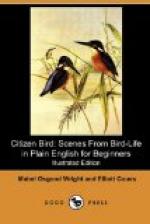“Or a hole in a tree,” added Rap.
“No, the Crossbill does not place his nest in any of these ways. He chooses a thick evergreen tree, and upon the fork of one of the branches makes a little platform of rubbish to support the nest. With great care the couple gather shreds of bark, twigs, and small sticks, till they think they have enough; then they begin the nest itself, weaving it of softer materials and lining it with grasses, fur, and feathers, until they make a very comfortable bed for the pale-green, purple-spotted eggs to lie in.”
“How cold the poor birds’ toes must be while they are working,” said Dodo with a shiver; “and I should think the eggs would freeze instead of hatching.”
“But what do they find to eat when everything is frozen stiff?” asked Rap. “Are they cannibal birds that can eat other birds and mice?”
“These two questions can be answered together,” said the Doctor. “The nests are usually built in evergreens, which are cone-bearing or coniferous trees. You all know what a cone is like, I think?”
“Yes, I do!” cried Rap. “It is a long seed pod that grows on evergreens. In summer it is green and sticky, but by and by it grows dry and brown, and divides into little rows of scales like shingles on a house, and there is a seed hidden under each scale. Each kind of an evergreen has a different-shaped cone; some are long and smooth like sausages, and some are thick and pointed like a top. The squirrels often pick the cones off the spruces over at the miller’s and shell out the scales, just as you shell corn off the cob, to get the seeds.”
“Very good, my boy,” said the Doctor. “I see you know something about trees as well as birds. The Crossbills build in evergreens, and all around their nests hang the cones with spicy seeds stored away under the scales, ready for the birds to eat. So they do not have to go far from home for their marketing.”
“But their beaks are so crooked that I don’t see how they can pick out the cone seeds,” said Nat.
“These curiously twisted bills, like pincers, are made expressly for the purpose of wrenching the scales from the cones, so that the seeds are laid bare.”
“It’s very funny,” said Nat; “whenever we think a bird is queer or awkward and would be better in some other way, it is sure to be made the very best way, only we don’t know it.”
“By and by, when the eggs are laid and the young are hatched,” continued the Doctor, “Crossbills make the most devoted parents; they would let themselves be lifted from the nest rather than leave their family.
“And when it is midsummer the old and young Crossbills form into flocks. Then the parents begin to think that the young people need a change of air for their health, and a few months of travel to finish their education. So they wander southward through the States without any method or plan, sometimes going as far as New Orleans before winter really begins; and it is on these journeys that we see them.




